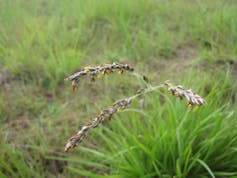[ad_1]
Genetically modified (GM) crops may be controversial, but similar processes happen naturally with wild plants. However, scientists have long been puzzled about how these processes happen. Our recent study may help researchers solve the mystery.
People often use the “tree of life” as a metaphor to describe the evolutionary relationships between organisms. The more closely related species are, the closer together they appear in the tree.
This is a bit misleading though, as reality is more complicated. Species don’t always split off along their own evolutionary path in isolation from other branches. In fact, in some groups of organisms, connections among branches are so common that we may need to abandon the notion of a tree of life altogether. This is particularly true for bacteria, where the evolutionary relationships look more like a tangled web than a tree. The crosstalk between branches is caused by the movement of genetic information.
Horizontal gene transfer (also known as lateral gene transfer) is the process by which pieces of DNA (such as genes) move between organisms outside of the usual parent to offspring route. It allows genetic information to be shared between distant branches of the tree of life without sexual reproduction, and it is responsible for the rapid spread of traits such as antibiotic resistance among bacteria.
Originally scientists thought this phenomenon was restricted to microbes, but we now know it also happens in a wide range of plants, animals and fungi, where it can spread the genetic recipe for traits that have an evolutionary advantage.
Horizontal gene transfer in grasses
Grasses are one of the most important groups of plants and include crops such as rice, wheat and maize. They cover almost 40% of the Earth’s landmass and make up the majority of human calorie intake.
Horizontal gene transfer between grass species has been found in wild and cultivated species alike. While we know these transfers happen from the marks they leave in species’ genomes (the entire set of DNA instructions in a cell), we still do not know the mechanism behind it. Neither do we know how often it happens – something our recent study, published in New Phytologist, aimed to address.
Zoran Zeremski/Shutterstock
Understanding the pace of horizontal gene transfer would allow us to assess its impact upon the planet and plant evolution and how quickly it can help plants to adapt to changes. For example, is it common enough that plants could already be using it in response to climate change?
We sequenced several genomes for the tropical grass Alloteropsis semialata to estimate the frequency of gene transfers into this species. Our study retraced the evolutionary history of each gene in the genome, identified genes that were of foreign origin, and worked out when and where they were transferred.

Marjorie Lundgren, CC BY-SA
Our findings showed that genes were continually acquired throughout the evolutionary history of this species, with a foreign gene incorporated approximately every 35,000 years.
However, this is a dramatic underestimate of the real rate of transfers into the species because it doesn’t show gene transfers that may have been lost afterwards. Most transferred genes are unlikely to give the recipient any benefit – and can even have negative consequences for the plant if they disrupt essential parts of the recipient’s genetic code. Genes that don’t offer the recipient an advantage are often lost. It’s much harder for scientists to detect these kinds of transient genes.
The genes that are retained are generally those that offer the recipient an evolutionary advantage. For example, many of the horizontally transferred genes detected in grasses offer disease resistance, stress tolerance and increased energy production. These genes may have been optimised in the genomes of the donor species for millions of years. Horizontal gene transfer allows the recipient to skip this long refinement process.
GM technology
Ultimately horizontal gene transfer and GM crops have the same outcome: a gene of foreign origin is inserted into a recipient’s genome.
Our study gave an insight into how often horizontal transfers are happening. But we still don’t know how genes are moving between distantly related species. There are many theories but we think a mechanism called reproductive contamination is most likely. It mirrors some of the methods used to make GM crops.
There are several different methods by which you can make a GM plant – some that require intense human intervention and some that don’t. Simple techniques such as repeated pollination or pollen tube pathway-mediated transfer require minimal human intervention. In these methods, small fragments of DNA from a third individual travel down the same pollen tube established by the father to contaminate the embryo in the seed. In theory this could occur naturally.
In the future we plan to test this idea and see if we can recreate some of the natural transfers we have documented. If successful, it may be time to reconsider how we view GM crops. Perhaps they are closer to natural processes than we think.
[ad_2]



